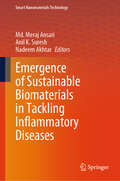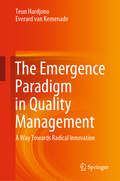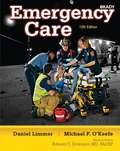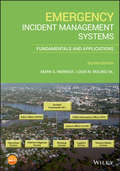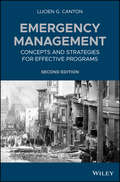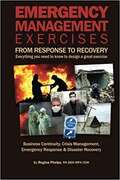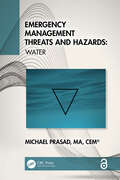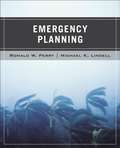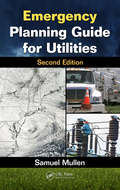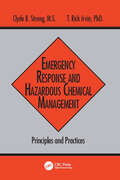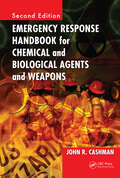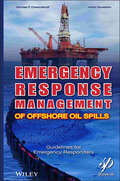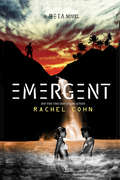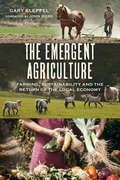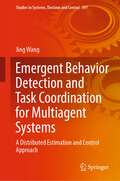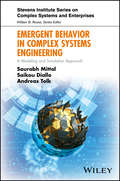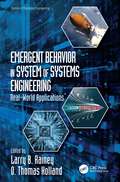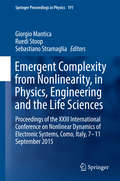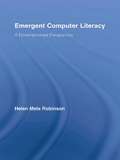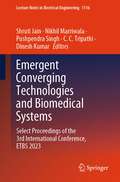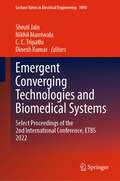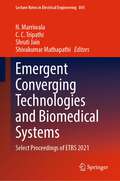- Table View
- List View
Emergence of Sustainable Biomaterials in Tackling Inflammatory Diseases (Smart Nanomaterials Technology)
by Anil K. Suresh Nadeem Akhtar Md. Meraj AnsariThis book presents the latest technology of sustainable nanomaterials for applications as drug delivery cargos in tackling various inflammatory diseases. The chapters in this book describe nanotechnology-based drug delivery strategies, the mechanistic insights of nanoformulations and their application in managing inflammation diseases such as rheumatoid arthritis, ulcerative colitis, cancer and neurological disorder. It looks into the challenges of using nanomaterials-based smart materials for enhanced therapeutic efficacy while maintaining safe and sustainable procedures. The book is divided into three main sections: A) Fundamental of smart nanocarriers and nanoformulations targeted drug delivery in inflammatory disease; B) Smart nano drug delivery therapy- an emerging approach towards inflammatory diseases and C) Novel nano delivery strategies in targeting major inflammatory diseases. The book targets early researchers and clinical practitioners who are interested in the management and treatment of inflammatory diseases using nanotechnology-based drug delivery systems.
The Emergence Paradigm in Quality Management: A Way Towards Radical Innovation
by Teun Hardjono Everard van KemenadeThis book is focused on quality management, and four different lenses which can be used to explore the phenomenon. It introduces emergence as a paradigm in thinking about quality, and explores conditions which are beneficial to radical innovation. The Emergence Paradigm in Quality Management provides an overview of the existing movements in thinking about quality, and discusses why these movements in fact represent paradigms. Three paradigms, the Empirical Paradigm, the Reference Paradigm and the Reflective Paradigm, are explained followed by a search for the Fourth Paradigm, the so-called Emergence Paradigm, which presents a route to radical innovation in organizations when plans, strategies and models fail. It presents the debates around the paradigms, and explores which is the best approach. This professional text will be ideal for strategy and policy makers wanting to establish a link between their conceived plans and the attention for quality, while finding ways to facilitate innovation. Professionals in a range of for-profit and non-profit organizations, including healthcare, will be able to expand their knowledge on quality management, operations management, and organizational studies.
Emergencies in Public Law
by Karin LoevyDebates about emergency powers traditionally focus on whether law can or should constrain officials in emergencies. Emergencies in Public Law moves beyond this narrow lens, focusing instead on how law structures the response to emergencies and what kind of legal and political dynamics this relation gives rise to. Drawing on empirical studies from a variety of emergencies, institutional actors, and jurisdictional scales (terrorist threats, natural disasters, economic crises, and more), this book provides a framework for understanding emergencies as long-term processes rather than ad hoc events, and as opportunities for legal and institutional productivity rather than occasions for the suspension of law and the centralization of response powers. The analysis offered here will be of interest to academics and students of legal, political, and constitutional theory as well as to public lawyers and social scientists.
Emergency Care (12th Edition)
by J. David Bergeron Edward T. Dickinson Michael F. O'Keefe Harvey D. Grant Robert H. Murray Jr. Daniel LimmerEmergency Care, Twelfth Edition, has set the standard for EMT training for over 30 years. Updated with the latest research and developments in emergency medical services, this edition meets the 2010 American Heart Association guidelines for CPR and ECC, providing all the practical information students need to succeed in the classroom and in the field. Using the National EMS Education Standards as a foundation, this edition goes beyond the Standards to provide the most current, accurate reflection of EMS practice today. Getting students to think like an EMT, the text integrates scientific principles in a way that's easy to understand, and a host of critical thinking features-including a new chapter, "Critical Thinking and Decision Making,"-helps students learn key concepts while getting a dose of the reality of being an EMT.
Emergency Guidance Methods and Strategies for Major Chemical Accidents
by Wenmei Gai Yunfeng DengThis book serves as a great reference for engineering technicians and researchers in a wide range of fields, including emergency management, public safety science, risk management, emergency communication, and transportation optimization. This book carried out researches about the public emergency behavior guidance strategies and methods for major chemical accidents. They put forward the classification model of emergency evacuation events, the selection of public emergency guidance strategies, the quantitative assessment of emergency response risk as well as the characteristics of sub-regional evacuation based on a wide range of theories, including safety engineering, social science, behavioral science, etc. Methods, such as case statistics and analysis, field research as well as modeling and simulation, were applied. Five chapters were covered by the book, including introduction of study background, statistics and analysis of hazardous chemical leakage accidents and emergency evacuation response in China in recent ten years, shelter-in-place risk assessment for high-pressure natural gas wells with hydrogen sulphide, dynamic emergency route planning, and characteristics analysis of sub-regional evacuation.
Emergency Incident Management Systems: Fundamentals and Applications
by Louis N. Molino Sr. Mark S. WarnickThe second edition was to be written in order to keep both reader and student current in incident management. This was grounded in the fact that incident management systems are continually developing. These updates are needed to ensure the most recent and relevant information is provided to the reader. While the overall theme of the book will remain the same of the first edition, research and research-based case studies will be used to support the need for utilizing emergency incident management systems. Contemporary research in the use (and non-use) of an incident management system provides clear and convincing evidence of successes and failures in managing emergencies. This research provides areas where first responders have misunderstood the scope and use of an emergency incident management system and what the outcomes were. Contemporary and historical (research-based) case studies in the United States and around the globe have shown the consequences of not using emergency incident management systems, including some that led to increased suffering and death rates. Research-based case studies from major incidents will be used to show the detrimental effects of not using or misunderstanding these principles. One of the more interesting chapters in the new edition is what incident management is used around the world.
Emergency Management: Concepts and Strategies for Effective Programs
by Lucien G. CantonProvides a comprehensive examination of emergency management and offers concepts and strategies for creating effective programs This book looks at the larger context within which emergency management response occurs, and stresses the development of a program to address a wide range of issues. Not limited to traditional emergency response to natural disasters, it addresses a conceptual model capable of integrating multiple disciplines and dealing with unexpected emergencies. Emergency Management: Concepts and Strategies for Effective Programs, Second Edition starts by focusing on the three pillars on which successful emergency management is based: an understanding of history, knowledge of social science research, and technical expertise in emergency management operations. It provides insight as to how emergency management has evolved and suggests reasons why the current method of response planning doesn’t work as well as it should. The book then goes on to discuss establishing and administering the emergency management program. It looks at the analysis of risk as the basis for strategy development, and considers both the traditional macro view of hazard identification and analysis as well as the micro view required for continuity planning. Strategy development is examined next, followed by coverage of planning process, techniques and methods. The book finishes with chapters on coordinating response, leading in crisis, and crisis management. Features two new chapters on the development of national response strategy and leadership in a crisis Incorporates the Principles of Emergency Management adopted by many emergency management professional associations and agencies Encourages the development of an enterprise wide program to address a wide range of potential threats Covers the various phases of comprehensive emergency management Integrates academic research with practical experience and case studies Emergency Management: Concepts and Strategies for Effective Programs is an important book that will benefit students, law enforcement, and state and local emergency managers and planners involved in emergency management.
Emergency Management Exercises from Response to Recovery: Everything You Need to Know to Design a Great Exercise
by Regina PhelpsExercises are a mainstay in the field of emergency management and business continuity planning. Although many companies conduct exercises, and the organizers may be emergency response subject matter experts, they do not excel in the discipline of designing and conducting the actual exercise – which means they simply don’t get the best results out of their effort. <p><p> This thoughtful book starts with a “silly little question”: Why are we doing this? What seems like a simple query is actually one of the keys to get the most out of every exercise you design. This text peels back the design process with the goal of creating the best experience possible. Whether you are developing a simple tabletop exercises or working on a full-scale extravaganza that resembles a Hollywood movie, this book will provide you with gems of wisdom that will make your next exercise sizzle. An internationally recognized expert in exercise design, Regina Phelps shares many of her secrets to ensure your exercise success.
Emergency Management Threats and Hazards: Water
by Michael PrasadEmergency Management Threats and Hazards: Water is a resource guidebook, which bridges the work of the emergency management practitioners and academic researchers, specifically for water-related incidents. Practitioners typically follow a disaster phase cycle of preparedness/protection/prevention, response, recovery, and mitigation – all of which have distinct actions and missions to reduce or eliminate adverse impacts from both threats and hazards. Academics will find the connections to allied fields such as meteorology, hydrology, homeland security, healthcare, and more. The book examines many of the distinct differences and variances within the specific scope of water-related incidents, crises, emergencies, and disasters. It provides examples and practical strategies for protection/prevention, response, recovery, and mitigation against adverse impacts to people, property, and organizations. It is also organized in the same construct used by emergency management practitioners (incident command system elements, disaster cycle phases, etc.), which will help align the academic world of emergency management education to both the practice and the training in the emergency management field. Takes a global view on threats and hazards, as well as their solutions. Provides a single repository of the majority of water-related incidents and provides a "how to" guide for resilience. Identifies cascading impacts and provides checklists for resolutions. Includes numerous case studies organized by threat and hazard. Chapter 2 of this book is freely available as a downloadable Open Access PDF at http://www.taylorfrancis.com under a Creative Commons [Attribution-NonCommercial-NoDerivatives (CC-BY-NC-ND)] 4.0 license.
Emergency Planning
by Ronald W. Perry Michael K. LindellIn order for a community to be truly prepared to respond to any type of emergency, it must develop effective emergency planning. Emergency Planning guides readers through the steps of developing these plans, offering a number of strategies that will help ensure success. It delves into the patterns of human disaster behavior, social psychology, and communication as well as the basics of generic protective actions, planning concepts, implementation, and action.
Emergency Planning Guide for Utilities
by Jérôme Pagès Samuel Mullen Francois LeAn increase in major natural disasters has led to heightened concerns about utility operations and public safety. Due to today's complex, compliance-based environment, utility managers and planners often find it difficult to plan for the action needed to help ensure organization-wide resilience and meet consumer expectations during these incidents. This volume offers a working guide that presents new and field-tested approaches to plan development, training, exercising, and emergency program management. The book will help utility planners, trainers, and responders to more effectively prepare for damaging events and improve the level of the utility‘s resilience.
Emergency Preparedness For Libraries
by Julie TodaroDespite the volumes of information they contain, few libraries know how to prepare for, endure, and survive any type of disaster. This completely updated second edition of Emergency Preparedness for Libraries provides library management with a comprehensive guide to planning and executing emergency procedures.
Emergency Response and Hazardous Chemical Management: Principles and Practices
by Clyde B. Strong T. Rick IrvinManagement of hazardous chemicals and materials-particularly during emergency release situations-is a critical part of routine training required for workers and professionals in the chemical, petroleum and manufacturing industries. Proper storage of highly reactive chemical agents, correct choice of protective clothing and safety issues in confined
Emergency Response Handbook for Chemical and Biological Agents and Weapons
by John R. CashmanUpdated to reflect the numerous advances that have evolved since the September 11 terrorist attacks, Emergency Response Handbook for Chemical and Biological Agents and Weapons, Second Edition maintains its reputation as a comprehensive training manual for emergency responders to incidents involving nuclear, biological, and chemical materials
Emergency Response Management of Offshore Oil Spills: Guidelines for Emergency Responders
by Nicholas P. Cheremisinoff Anton DavletshinEMERGENCY RESPONSE MANAGEMENT OF OFFSHORE Examines the Deepwater Horizon disaster and offers processes for safety and environmental protection Though renewable energy is a growing piece of the energy “pie,” fossil fuels still dominate our energy supplies and will continue to do so for decades. This makes offshore drilling, especially in places like the Gulf of Mexico and North Sea, extremely important for the future of the world’s energy supply. Unfortunately, the world has been witnessing, over and over again, accidents, deadly explosions, spills, and environmental disasters that could have been avoided with proper safety and environmental processes put in place. The Deepwater Horizon catastrophe is the largest offshore oil spill in U.S. history and an ecological nightmare of epic proportions. Emergency Response Management of Offshore Oil Spills aids in the response of this and future disasters by providing this handy reference volume for engineers, managers, and other emergency responders. This timely publication outlines the toxic nature of crude oil, covering properties of crude oil, chemical composition, toxicity to humans and marine life, and investigates the impact of oil spills from historical case studies. The current arsenals available to address oil spills, such as dispersants, absorbing booms, skimming, and other methods, are also discussed. Technologies that are rapidly being developed to address the Gulf Oil Spill are considered, along with extensive information on chemical protective clothing, air monitoring, respiratory protection, management of waste, and much more. The book concludes with a chapter discussing responsible care and takes a critical look at the reasons why the Deepwater Horizon rig catastrophe happened and examines the follow-up that ensued after the incident. Emergency Response Management of Offshore Oil Spills provides: Examples of 26 major oil spills ranked from largest to smallest, describing each incident and the amount of oil spilledRecommendations and guidance on proper air monitoring methods Suggestions related to protective garments such as respirators Comparative product information on chemical dispersants, shoreline bleaching and cleaning chemicals Detailed toxicity data for humans and marine life Discussions in the areas of deficiencies in responding to spills and why the oil industry needs to be more responsive to developing technologies Hazardous materials protocols, including OSHA- and EPA- recommended safe work practices for dealing with hazardous materials
Emergent (A Beta Novel)
by Rachel CohnA clone revolution is brewing.Zhara, the First. Elysia, her clone. On the surface, they are identical. But looks can be deceiving. When Zhara plays, she plays to win. She thought she had escaped the horrors of Doctor Lusardi's cloning compound. But the nightmare is just beginning. Elysia has taken everything from Zhara--a softer, prettier version of herself and an inescapable reminder of all she's failed at in her life. Now the man Zhara loves has replaced her with Elysia. Zhara will get her clone out of the way, no matter the cost. Elysia has finally learned the truth: she has a soul. Her First is alive. She knows it hurts Zhara to see her with Alexander, but she can't give him up. The genetically-perfected Aquine has chosen as her as his life mate, and their days together are limited. Elysia can't remain in the Rave Caves off the shores of Denesme forever. Revolution is brewing on the island paradise. Hundreds of soulless clones remain imprisoned like Elysia once was, slaves to the whims of their owners--wealthy human inhabitants of the island. As a group of clones and humans, led by Alexander, plot an insurrection that will turn Denesme's world upside down, Elysia knows her place is fighting by his side. Terrible sacrifices must be made to defeat Denesme's twisted regime. But even the greatest losses cannot prepare Elysia for the ticking time bomb built into her own programming...
The Emergent Agriculture
by Gary Kleppel John IkerdLong embraced by corporations who are driven only by the desire for profit, industrial agriculture wastes precious resources and spews millions of tons of greenhouse gases into the atmosphere each year, exacerbating climate change and threatening the very earth and water on which we depend. However, this dominant system, from which Americans obtain most of their food, is being slowly supplanted by a new paradigm.The Emergent Agriculture is a collection of fourteen thematic essays on sustainability viewed through the lens of farming. Arguing that industrial food production is incompatible with the realities of nature, science, and ethics, this lyrical narrative makes the case for a locally based food system which is: Stable in the face of economic uncertainty Resilient in the face of environmental variability Grounded in stewardship of the land, on attaching value to food and the craft involved in producing it, and on respecting the dignity of farmers, consumer,s and livestockA revolution in food production is underway. Written from the vantage point of an ecologist who is also a farmer, The Emergent Agriculture is essential reading for anyone interested in food security and the potential for growing local economies. Food for thought about the future of food.Gary Kleppel is a professor of biology at the SUNY Albany, where he focuses on sustainable agriculture, conservation-based grazing, and the ecology of human-dominated landscapes. He and his wife Pam are owners of Longfield Farm, where they produce grass-fed lamb, wool, free range chickens and eggs, and artisanal breads.
Emergent Behavior Detection and Task Coordination for Multiagent Systems: A Distributed Estimation and Control Approach (Studies in Systems, Decision and Control #397)
by Jing WangThis book addresses problems in the modeling, detection, and control of emergent behaviors and task coordination in multiagent systems. It presents a unified solution to such problems in terms of distributed estimation, distributed control, and optimization of interaction topologies and dynamics.Four aspects of the technical solutions in the book are presented: First, the impact of interaction dynamics on the convergence conditions related to interaction topologies is discussed, utilizing a discontinuous cooperative control algorithm of updated design. Second, distributed least-squares and Kalman filtering algorithms for agents with limited interactions are elaborated upon. Third, a general framework of distributed nonlinear control is established, and distributed adaptive control for nonlinear systems with more general uncertainties is presented. Based on the proposed framework, a distributed nonlinear controller is designed to deal with task coordination of robotic systems with nonholonomic constraints. Finally, the problem of optimal multiagent task coordination is addressed and solutions based on approximate dynamic programming and approximate distributed gradient estimation are presented.Emergent Behavior Detection and Task Coordination for Multiagent Systems is of interest to practicing engineers in areas such as robotics and cyber-physical systems, researchers in the field of systems, controls, and robotics, and senior undergraduate and graduate students.
Emergent Behavior in Complex Systems Engineering: A Modeling and Simulation Approach (Stevens Institute Series on Complex Systems and Enterprises)
by Saurabh Mittal Saikou Diallo Andreas TolkA comprehensive text that reviews the methods and technologies that explore emergent behavior in complex systems engineering in multidisciplinary fields In Emergent Behavior in Complex Systems Engineering, the authors present the theoretical considerations and the tools required to enable the study of emergent behaviors in manmade systems. Information Technology is key to today’s modern world. Scientific theories introduced in the last five decades can now be realized with the latest computational infrastructure. Modeling and simulation, along with Big Data technologies are at the forefront of such exploration and investigation. The text offers a number of simulation-based methods, technologies, and approaches that are designed to encourage the reader to incorporate simulation technologies to further their understanding of emergent behavior in complex systems. The authors present a resource for those designing, developing, managing, operating, and maintaining systems, including system of systems. The guide is designed to help better detect, analyse, understand, and manage the emergent behaviour inherent in complex systems engineering in order to reap the benefits of innovations and avoid the dangers of unforeseen consequences. This vital resource: Presents coverage of a wide range of simulation technologies Explores the subject of emergence through the lens of Modeling and Simulation (M&S) Offers contributions from authors at the forefront of various related disciplines such as philosophy, science, engineering, sociology, and economics Contains information on the next generation of complex systems engineering Written for researchers, lecturers, and students, Emergent Behavior in Complex Systems Engineering provides an overview of the current discussions on complexity and emergence, and shows how systems engineering methods in general and simulation methods in particular can help in gaining new insights in complex systems engineering.
Emergent Behavior in System of Systems Engineering: Real-World Applications
by Larry B. Rainey O. Thomas Holland"This book compiles real-world case studies on discovering, understanding and engineering emergent behaviors in a computational environment across multiple application domains such as wargaming, biology, IoT, disaster management and space architecting. All the application domains are described through an undercurrent of System of Systems (SoS) engineering in conjunction with theoretical foundations required for engineering a Modeling and Simulation SoS capable of displaying valid emergent behavior. An excellent read and state-of-the-art in M&S of emergent behavior in complex systems!" --Dr. Saurabh Mittal, Department Chief Scientist, The MITRE Corporation This book is the of its kind to address real-world applications of the phenomenon of emergent behavior in real-world system of systems. It launches from the foundation of theory and basic understanding of the subject of emergent behavior as found in system of systems applications. It includes real-world examples where emergent behavior is manifested. Each chapter addresses the following major points, which are exploratory in nature: the physical results of the presence of emergent behavior; the implications for the existence of emergent behavior; the manifestation of emergent behavior; and methods to either control emergent behavior assuming its effects are negative in nature, or capitalize on emergent behavior given its effects are positive in nature.
Emergent Complexity from Nonlinearity, in Physics, Engineering and the Life Sciences
by Giorgio Mantica Ruedi Stoop Sebastiano StramagliaThis book collects contributions to the XXIII international conference "Nonlinear dynamics of electronic systems". Topics range from non-linearity in electronic circuits to synchronisation effects in complex networks to biological systems, neural dynamics and the complex organisation of the brain. Resting on a solid mathematical basis, these investigations address highly interdisciplinary problems in physics, engineering, biology and biochemistry.
Emergent Computer Literacy: A Developmental Perspective (Routledge Research in Education)
by Helen Mele RobinsonThe United States is currently grappling with how to prepare our students to be computer literate citizens in the competitive technological world we live in. Understanding how children develop computer knowledge, and the ways that adults are able to guide their computer learning experiences, is a vital task facing parents and educators. This groundbreaking book is an attempt to fill a gap in current understanding of how we become computer literate and proposes a theory of how computer literacy skills emerge in computer users.
Emergent Converging Technologies and Biomedical Systems: Select Proceedings of the 3rd International Conference, ETBS 2023 (Lecture Notes in Electrical Engineering #1116)
by Shruti Jain Nikhil Marriwala Pushpendra Singh C. C. Tripathi Dinesh KumarThe book contains proceedings of the International Conference on Emergent Converging Technologies and Biomedical Systems ETBS 2023. It includes papers on wireless multimedia networks, green wireless networks, electric vehicles, biomedical signal processing, and instrumentation, wearable sensors for health care monitoring, biomedical imaging, and bio-materials, modeling, and simulation in medicine biomedical, and health informatics. The book serves as a useful guide for educators, researchers, and developers working in the areas of signal processing, imaging, computing, instrumentation, artificial intelligence, and their related applications. This book also provides support and aid to the researchers involved in designing the latest advancements in healthcare technologies.
Emergent Converging Technologies and Biomedical Systems: Select Proceedings of the 2nd International Conference, ETBS 2022 (Lecture Notes in Electrical Engineering #1040)
by Shruti Jain Nikhil Marriwala C. C. Tripathi Dinesh KumarThe book contains proceedings of the International Conference on Emergent Converging Technologies and Biomedical Systems ETBS 2022. It includes papers on wireless multimedia networks, green wireless networks, electric vehicles, biomedical signal processing and instrumentation, wearable sensors for health care monitoring, biomedical imaging, & bio-materials, modeling and simulation in medicine biomedical, and health informatics. The book will serve as a useful guide for educators, researchers, and developers working in the area of signal processing, imaging, computing, instrumentation, artificial intelligence, and their related applications. This book will also provide support and aid to the researchers involved in designing the latest advancements in healthcare technologies.
Emergent Converging Technologies and Biomedical Systems: Select Proceedings of ETBS 2021 (Lecture Notes in Electrical Engineering #841)
by N. Marriwala C. C. Tripathi Shruti Jain Shivakumar MathapathiThe book contains peer-reviewed proceedings of the International Conference on Emergent Converging Technologies and Biomedical Systems 2021. It includes papers on wireless multimedia networks, green wireless networks, electric vehicles, biomedical signal processing and instrumentation, wearable sensors for health care monitoring, biomedical imaging, & bio-materials, modeling and simulation in medicine biomedical and health informatics. The book will serve as a useful guide for educators, researchers, and developers working in the area of signal processing, imaging, computing, instrumentation, artificial intelligence, and their related applications. This book will also provide support and aid to the researchers involved in designing the latest advancements in healthcare technologies.
